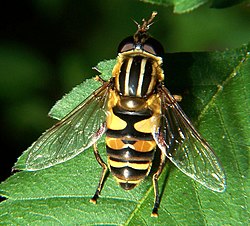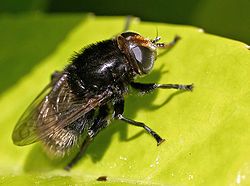Top Qs
Timeline
Chat
Perspective
List of Syrphidae genera
From Wikipedia, the free encyclopedia
Remove ads
The family Syrphidae consists of more than 6000 living species of hoverfly. The internal taxonomy of the family and the number of genera varies greatly between sources leading to considerable discrepancy across the literature. This is currently in the process of reorganization on the basis of phylogenetic studies but knowledge is still incomplete, especially in light of recent studies of larval characters suggesting relationships which don't correspond with the phylogeny based solely on adult characters.
The current classification is therefore still based on the morphology of adults and basically refers to the taxonomic scheme adopted by Thompson & Rotheray in the Manual of Palaearctic Diptera (1998), which divides the family into three subfamilies and fourteen tribes.
The nomenclature given here is derived partly from the BioSystematic Database of World Diptera (BDWD), and a working classification created by a group of molecular biologists which no doubt will alter greatly in the future.[2]
The distribution of genera in biogeographic realms is derived from the biosystematics BDWD.
Remove ads
Legend
- AF: Afrotropical realm
- AU: Australasian realm
- NE: Nearctic realm
- NT: Neotropical realm
- OR: Oriental realm
- PA: Palearctic realm
Eristalinae
Summarize
Perspective
The subfamily Eristalinae (=Milesiinae) is subdivided into 9 tribes.
Tribe: Brachyopini
(=Chrysogasterini Shannon, 1922)
Subtribe: Brachyopina
Subtribe: Spheginina
|
|
Tribe: Callicerini
(=Calliceratinae Brues & Melander, 1932)
- Callicera Panzer, 1809: NE NT OR PA
- Notiocheilosia Thompson, 1972: NT
Tribe: Cerioidini
|
(=Ceriini, Cerioidinae Wahlgren, 1909)
|
|
Tribe: Eristalini
Subtribe: Eristalina
|
|
Subtribe: Helophilina
|
|
Tribe: Sericomyiini
|
- sometimes regarded as a subtribe of the Eristalini
|
|
Tribe: Eumerini
(=Merodontini, Medorontinae Edwards, 1915, Medorontinae Bezzi, 1915, Medorontidae Glumac & Vujic, 1990, Nausigasterinae Shannon, 1921)
|
|
Tribe: Milesiini
(=Xylotini)
Subtribe: Blerina
|
|
Subtribe: Criorhinina
|
|
Subtribe: Milesiina
|
|
Subtribe: Temnostomina
|
|
Subtribe: Tropidiina
|
|
Subtribe: Xylotina
|
|
Tribe: Rhingiini
(=Cheilosiini Cockerell, 1917)
Subtribe: Cheilosiina
Subtribe: Pelecocerina
Subtribe: Psarina
Subtribe: Rhingiina |
|
Tribe: Volucellini
|
|
Remove ads
Microdontinae
Summarize
Perspective
The arrangement of genera here follows the extensive revision carried out by Reemer & Ståhls (2013).[5]
Tribe: Microdontini
Tribe: Spheginobacchini
|
|
Remove ads
Pipizinae
The subfamily Pipizinae was formerly considered a tribe within Eristalinae, but a recent phylogenetic analysis suggests it should be ranked as a separate subfamily (Mengual, 2015)[15].
- Cryptopipiza Mutin, 1998
- Heringia (=Cnemodon): NE PA
- Subgenera:
- H. (Heringia) Rondani, 1856
- H. (Neocnemodon) Goffe, 1944
- Subgenera:
- †Oligopipiza Nidergas, Hadrava, Nel et al., 2018 (a fossil genus from Middle Oligocene ~28 MYR-BP): PA
- Pipiza Fallén, 1810 (=Pseudopipiza): NE NT PA
- Pipizella Rondani, 1856: PA
- Trichopsomyia Williston, 1888 (=Halictomyia): NE NT OR PA
- Triglyphus Loew, 1840: AU OR PA
Remove ads
Syrphinae
Summarize
Perspective
The subfamily Syrphinae is subdivided into 4 well established tribes. For table of genera, subgenera, authors and types see Mengual et al (2008)
Tribe: Bacchini
(=Melanostomatini)
|
|
Tribe: Paragini
|
|
Tribe: Syrphini
(=Chrysotoxini). In Mengual et al. (2008) this tribe was resolved into two groups.
Syrphini (Group 1)
|
|
Syrphini (Group 2)
|
|
Syrphini (Group undetermined)
- Agnisyrphus Ghorpade, 1994: OR
- Asiodidea Stackelberg, 1930: PA
- Dideomima Vockeroth, 1969: NE NT
- Doros Meigen, 1803: NE PA
- Lamellidorsum Huo & Zheng, 2005: PA
- Pelloloma Vockeroth, 1973: AF
- Rhinobaccha Meijere, 1908: OR
- Vockerothiella Ghorpade, 1994 : OR
Tribe: Toxomerini
Remove ads
Genera of uncertain affinities
This section contains a list of genera for which the bibliography does not provide a clear systematic position. These genera are not intended as incertae sedis: It is likely that they have been given a formal taxonomic description or been defined in a subsequent revision, but not in the works consulted.
- Pia Philippi, 1865: NT
- Poliomyia Scudder, 1878: NE
- Spheginascia Meunier, 1901: PA
See also
Notes
Wikiwand - on
Seamless Wikipedia browsing. On steroids.
Remove ads









































































